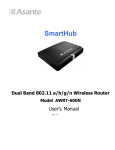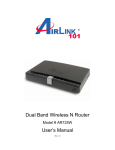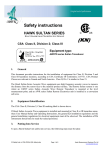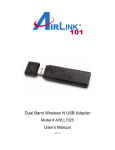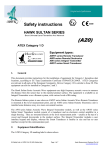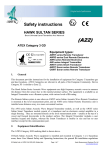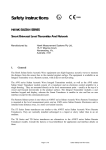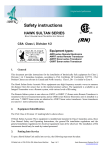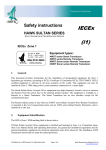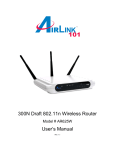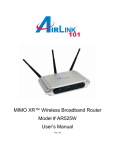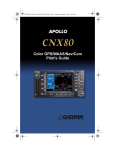Download Asante AWRT-550N
Transcript
SmartHub 802.11 b/g/n Wireless Router Model AWRT-550N User’s Manual Rev. 1.0 Table of Contents 1. Introduction................................................................................................................................. 3 1.1 Package Contents.................................................................................................................. 3 1.2 Features................................................................................................................................. 3 2. Connecting the Router ................................................................................................................ 4 3. Configuring the Router ............................................................................................................... 5 Cable Modem.............................................................................................................................. 5 DSL............................................................................................................................................. 6 4. Verifying Connection.................................................................................................................. 8 5. Connecting to the Router Wirelessly .......................................................................................... 9 6. Web Configuration Utility ........................................................................................................ 10 6.1 Setup ................................................................................................................................... 10 6.1.1 Setup > Basic Setup ..................................................................................................... 10 6.1.2 Setup > DDNS ............................................................................................................. 16 6.1.3 Setup > MAC Address Clone ...................................................................................... 17 6.1.4 Setup > Advanced Routing .......................................................................................... 18 6.2. Wireless.............................................................................................................................. 19 6.2.1 Wireless > Basic Wireless Settings ............................................................................. 19 6.2.2 Wireless > Wireless Security....................................................................................... 21 6.2.3 Wireless > Wireless MAC Filter ................................................................................. 30 6.2.4 Wireless > Advanced Wireless Settings ...................................................................... 31 6.3 Security ............................................................................................................................... 33 6.3.1 Security > Firewall....................................................................................................... 33 6.4 Access Restrictions ............................................................................................................. 35 6.4.1 Access Restrictions > Internet Access Policy.............................................................. 35 6.5 Applications & Gaming ...................................................................................................... 39 6.5.1 Applications & Gaming > Single Port Forwarding ..................................................... 39 6.5.2 Applications & Gaming > Port Range Forwarding ..................................................... 40 6.5.3 Applications & Gaming > DMZ.................................................................................. 42 6.5.4 Applications & Gaming > QoS.................................................................................... 43 6.6 Administration .................................................................................................................... 51 6.6.1 Administration > Management .................................................................................... 51 6.6.2 Administration > Log................................................................................................... 52 6.6.3 Administration > Diagnostics ...................................................................................... 53 6.6.4 Administration > Factory Defaults .............................................................................. 54 6.6.5 Administration > Firmware Upgrade........................................................................... 55 6.7 Status................................................................................................................................... 56 6.7.1 Status > Router............................................................................................................. 56 6.7.2 Status > Local Network ............................................................................................... 57 6.7.3 Status > Wireless Network .......................................................................................... 58 7. Specifications............................................................................................................................ 59 Appendix – Information................................................................................................................ 60 Technical Support ......................................................................................................................... 60 2 1. Introduction Thank you for purchasing Asante AWRT-550N Smart Wireless N Router. The AWRT-550N Wireless N Router provides 2.4 GHz wireless frequency which allow more clean channels and less interference for your wireless network. A full range of security features such as WPA2-PSK, WPA-PSK, and WEP provide the highest level of wireless network security. The built-in SmartHub Web Configuration Utility has a unique ‘Easy Set up’ option that allows one to set up the router with no or minimum networking knowledge. The built-in Web Configuration Utility also has the regular path to set up the router with an easy-to-use user interface. AWRT-550N also has a USB port for connecting USB devices such as external hard drive, thumb drive or USB printer to the network. In this way, devices can be easily shared by users connected to the router. SmartHub is a router with a very innovative design (Patent Pending) where offers user a smart way to reach and to manage this router. The innovative features of this design include : 1) It can smartly redirect a login page and authenticate user whenever user bring up a browser. This significantly eliminates the burden to user who needs to remember the IP address and technologies and figure out how to access a router. 2) It can be reached by entering “smarthub” on any browser and anytime. This design makes SmartHub become a very friendly device instead of awkward IP address. 3) It can manage a list of user’s name and password so that administrator can easily create/delete/monitor the user status without entering computer’s machine ID(MAC address) or dynamic changing IP address). 4) Offers 2 levels of security system - (a) user access control and (b) wireless security where user can has it discretion to select its provisioning depend on its need. Today’s Wifi encryption is a complex technology that vertically increase the challenge to all users to know how to use it. And yet, SmartHub gives a very efficient way and also retain wifi security requirements. 5) This access control method can persistently authenticate user whenever user’s trying to reconnect to SmartHub. New user could be easily added on by creating a username and password in a minute. Likewise, it can be erased afterward and without changing entire security setting. Today’s Wifi static system, administrator may need to force to change setting after new user is off and impact to all existing user to adopt new setting. 6) Smarthub’s smart access control method could be disabled if user has no need to control security in this fashion. Simple go to Advanced Set Up-> management, and disable it. 1.1 Package Contents Before you begin the installation, please check the items of your package: SmartHub AWRT-550N Wireless N Router Power Adapter Ethernet Cable (Cat.5) 3 Manual CD Quick Installation Guide If any item contained is damaged or missing, please contact your local dealer immediately. Also, keep the box and packaging materials in case you need to ship the unit in the future. 1.2 Features • • • • • • • • • • Smart Setup, Management, Control. 2.4GHz single band AP. More channels, less interference — ideal for wireless congested area Highest wireless data rate of up to 300Mbps* with 802.11n draft 2.0 WPS button for easy connection with your WPS support wireless adapters Enjoy HD video streaming, gaming and VoIP with powerful 802.11n Wireless technology Advanced NAT+SPI firewall provides fully protection for your wireless connection QoS (Quality of Service) designed for prioritizing various data traffic to allow downloading files and playing movies, music, or online gaming at the same time with uninterrupted data streaming Supports Universal Plug and Play Fully backward compatible with 802.11b/g 4 2. Connecting the Router Note: Prior to connecting the router, be sure to power off your computer, DSL/Cable modem, and the router. Step 1 Connect one end of a network cable to the INTERNET(yellow) port of the router and connect the other end of the cable to the DSL/Cable modem. Step 2 With another network cable, connect one end of the cable to your computer’s Ethernet port and connect the other end to one of the LAN ports of the router. Step 3 Power on the DSL/Cable modem and wait for the lights on the modem to become stable. Step 4 Plug the power adapter to the router and connect to an outlet or power strip. Step 5 Power on your computer. Step 6 Make sure the INTERNET, WIRELESS, and the LAN port that the computer is connected to are lit. If not, try the above steps again. LED Indicators: How the router connects: 5 3. Configuring the Router After all components in the previous picture are connected and powered up, follow the steps below to configure the router. Step 1 Open the web browser (Internet Explorer/Mozilla Firefox/Safari/Chrome). If this is the first time, the logon page below should appear. Or you can type “smarthub” or “192.168.1.1” on the browser. . Otherwise the regular user page below will appear below after 1st administrator created the user profile. 6 Step 2 Enter admin for both the username and password fields and click OK. The page below should appear. The sections below cover the ‘Advanced Set Up’ option. The ‘Easy Set Up’ will automatically guide you accordingly with online help menu. It is very simple and straightforward set up procedure which will not describe in this manual. The Cable Modem For most cable modem users, you should be able to connect to the Internet without any configuration. Automatic Configuration – DHCP is usually the default Internet Connection Type. If your ISP has provided you with a host name, enter it in the optional Host Name field. Click Save Settings to save the settings. 7 If your ISP requires a registered MAC Address, click on the MAC Address Clone tab select Enabled, and click on the Clone My PC’s MAC button. Click Save Settings to save the settings. If you have trouble connecting to the Internet, please refer to Section 4, Verifying Connection. 8 DSL For DSL users, follow the steps below to configure the router. Step 1 Select PPPoE from the drop-down menu. 9 Step 2 Enter your username and password provided by your ISP. Note: Depending on the ISP, you may need to include the domain name with your username. Example: [email protected] Step 3 Click Save Settings to save the settings. You should be able to connect to the Internet now with the wired computer. If you have trouble connecting to the Internet, please refer to Section 4, Verifying Connection. Connect each of your wired computers to an available LAN port on the Router with an Ethernet cable, and then restart the computer. These computers should be able to connect to the Internet immediately. 4. Verifying Connection If you have trouble connecting to the Internet, try the following steps. Step 1 Power off the Cable/DSL modem, router, and computer and wait for 5 minutes. 10 Step 2 Turn on the Cable/DSL modem and wait for the lights on the modem to settle down. Step 3 Turn on the router and wait for the lights on the router to settle down. Step 4 Turn on the computer. Step 5 Log in to the router and select the Status tab. Step 6 Verify that the Internet IP Address, Default Gateway, and at least one of the DNS fields have valid numbers assigned to them (instead of all 0’s). If each field has a valid numbers(not all 0’s) assigned, the router is connected to the Internet. 11 5. Connecting to the Router Wirelessly Below are the default wireless settings of the router. You must configure your wireless network card to the same settings in order to establish a wireless connection to the router. Please refer to your wireless network card’s manual on how to configure these settings. SSID: default Network Mode: BGN-Mixed Authentication: Open System Channel #: 6 WEP: disabled If you want to change the router’s wireless and security settings, log in to the router and select the Wireless tab. Click on Manual button. Click Save Settings to save the settings after you make changes. 12 6. Web Configuration Utility This router has a built-in web configuration utility that you can use to configure the router’s settings. Simply log in to the router using your computer’s web browser. 6.1 Setup 6.1.1 Setup > Basic Setup This is the default screen when you log in to the router’s web configuration utility and select ‘Advanced Set Up’. You can setup your Internet connection here as well as configuring the Network and DHCP server settings and selecting your Time Zone. 13 Internet Setup There are six Internet Connection Types: DHCP, PPPoE, Static IP, PPTP, L2TP, and Telstra Cable. Automatic Configuration - DHCP When your ISP provides dynamic IP, you can keep this default setting (This is for most cable modem users). Usually you should be able to connect to the Internet without changing any configuration. If your ISP has provided you with a host name, enter it in the optional Host Name field. Click Save Settings to save the settings. PPPoE Usually DSL service provider uses PPPoE for Internet connection. You will need to provide username and password given by your ISP to connect to the Internet. 14 Static IP Select Static IP if your ISP provided you the static IP address, Subnet Mask, Default Gateway and DNS server addresses for Internet connection. PPTP Point-to-Point Tunneling Protocol (PPTP) is a service that applies to connections in Europe only. Enter the Internet connection information provided by your ISP accordingly. 15 L2TP L2TP is a service that applies to connections in Israel only. Enter the Internet connection information provided by your ISP accordingly. Telstra Cable Telstra Cable is a service that applies to connections in Australia only. Enter the Internet connection information provided by your ISP accordingly. 16 Network Setup Router IP You can change the Router’s IP Address and its Subnet Mask for the local network. DHCP Server Setting The Router has a built-in DHCP server which can dynamically assign IP address to each device on your network. The DHCP Server is Enabled by default, if you already have a DHCP server on the network, you need to select Disabled. Start IP Address: Give a value for the dynamically assigning IP address to start with. Because the Router’s default IP address is 192.168.1.1, the Starting IP Address must be 192.168.1.2 or greater, but smaller than 192.168.1.253. The default Starting IP Address is 192.168.1.100. Maximum Number of Users: Enter the maximum number of PCs that you want the DHCP server to assign IP addresses to. This number cannot be greater than 253. The default is 50. Client Lease Time: The Client Lease Time is the amount of time a network user will be allowed connection to the Router with their current dynamic IP address. The default is 24 hours. Static DNS 1~3: Enter up to 3 DNS addresses for your network. DHCP Reservation: If you want to assign a static IP Address to one of the computers in your network, click on the DHCP Reservation button. 17 Step 1 Enter the Static IP Address in the Assign this IP field. Step 2 Enter the MAC address of the corresponding computer in the To this MAC field. Step 3 Check the Add button. Step 4 Click Save Settings. Time Settings Set up the time zone and daylight saving for the Router. 18 6.1.2 Setup > DDNS Dynamic DNS (DDNS) allows any user who wishes to access your server to reach it by a registered DNS name instead of an IP address. Before you enable DDNS, you need to register an account with one of the DDNS providers listed in the drop-down menu. To Enable DDNS, select the DDNS provider you have registered with and enter the required fields. Click Save Settings to save the settings. 19 6.1.3 Setup > MAC Address Clone Some ISPs require a registered MAC address to access the Internet. You can use the following steps to clone your PC’s registered MAC address to access the Internet. Step 1 Check the radio button Enabled . Step 2 Click the Clone My PC’s MAC button. Step 3 Click Save Settings to save the settings. 20 6.1.4 Setup > Advanced Routing You can configure your own static routing table using the Advanced Routing function. To see the current routing table, click on Show Routing Table button. Be sure to click Save Settings to save each entry. 21 6.2. Wireless 6.2.1 Wireless > Basic Wireless Settings Wireless Configuration - Manual To configure the Wireless settings, click radio button Manual. 22 You can configure the router’s basic wireless settings on this screen. Network Mode: If you have 802.11b/g/n 2.4GHz devices on the wireless network, select BGN-Mixed. If you have 802.11a/n 5GHz devices on the wireless network, select AN-Mixed. Note: If your wireless computer cannot detect the router after you selected AN-Mixed, please make sure your wireless adapter supports 5GHz frequency band. Network Name (SSID): You can change the router’s SSID in this field. Once you have changed the SSID, your network clients need to re-connect themselves using the new SSID. Channel: Select the desired channel. All the network clients need to use the same channel. Radio Band: For best performance in a network, keep the default, Auto – 20/40MHz Channel. Standard Channel: If you selected Auto – 20/40MHz Channel for the Radio Band setting, then this setting will be your primary Wireless N channel. If you are not sure which channel to select, keep the default, Auto. 23 Extension Channel: Select the extension channel for Wireless N extended radio band. If you are not sure which channel to select, keep the default, Auto. SSID Broadcast: Choose to enable or disable the broadcast of your SSID (wireless network name). 6.2.2 Wireless > Wireless Security You can configure wireless security such as WPA2 or WEP encryption on this screen. Note: WPA2 Personal is the most secured encryption mode for general users. WEP is the most common encryption but the least secured. It is recommended to use WPA2 Personal AES for your wireless security if all the wireless devices on your network support this mode. All of the wireless clients must use the same security settings in order to connect to the router. WEP To enable WEP, select WEP from the Security Mode. 24 Encryption: Choose 64 bits or 128 bits Passphrase: You can enter a passphrase and click on the Generate button and the router will automatically generate four WEP keys for you. WEP Key 1 – 4: Manually assign a passphrase for each key. If you selected 64 bits encryption, enter 10 HEX characters (0-F) for each key. If you selected 128 bits encryption, enter 26 HEX characters (0-F) for each key. TX Key: Select a key to be the active key. Click Save Settings to save the settings. WPA Personal Select WPA Personal from the Security Mode. Encryption: Select either TKIP or AES as the encryption method. Passphrase: Enter a passphrase between 8 to 63 characters long. Key Renewal: Enter the desired key renewal time in seconds. Click Save Settings to save the settings. 25 WPA2 Personal Select WPA2 Personal from the Security Mode. Encryption: Select either TKIP or AES as the encryption method. Passphrase: Enter a passphrase between 8 to 63 characters long. Key Renewal: Enter the desired key renewal time in seconds. Click Save Settings to save the settings. 26 WPA Enterprise Select WPA Enterprise from the Security Mode. Encryption: Select either TKIP or AES as the encryption method. RADIUS Server: Enter the IP Address of your RADIUS server. RADIUS Port: Enter the port number of your RADIUS server. Shared Secret: Enter the shared key. Key Renewal: Enter the desired key renewal time in seconds. Click Save Settings to save the settings. 27 WPA2 Enterprise Select WPA2 Enterprise from the Security Mode. Encryption: Select either TKIP or AES as the encryption method. RADIUS Server: Enter the IP Address of your RADIUS server. RADIUS Port: Enter the port number of your RADIUS server. Default is 1812. Shared Secret: Enter the shared key. Key Renewal: Enter the desired key renewal time in seconds. Click Save Settings to save the settings. 28 Radius This option features WEP used in coordination with a RADIUS server. (This should only be used when a RADIUS server is connected to the Router.) Encryption Methods: Select either TKIP or AES as the encryption method. RADIUS Server: Enter the IP Address of your RADIUS server. RADIUS Port: Enter the port number of your RADIUS server. Shared Secret: Enter the shared key. Encryption: Select a level of WEP encryption, 64 bits 10 hex digits or 128 bits 26 hex digits. The default is 64 bits 10 hex digits. Passphrase: Enter a Passphrase to automatically generate WEP keys. Then click Generate. Key 1-4: If you did not enter a Passphrase, enter the WEP key(s) manually. Tx Key: Select a key from the drop-down menu. 29 Wireless Configuration - WiFi-Protected Setup To use Wi-Fi Protected Setup, click on WiFi-Protected Setup radio button in ‘Basic Wireless Settings’ page. WiFi Protected Setup supports two types of connection: Push Button Configuration (PBC) or Personal Identification Number (PIN). If you choose to use PBC on your client device to connect to the router, click on the WPS software button . If you choose to use PIN on your client device, you need to enter the PIN number generated by the client device into the blank and click Register. Connecting to the Router with WPS Push Button (Optional) AWRT-550N Wireless N Router supports hardware WiFi-Protected Setup (WPS) push button which allows you to connect your wireless computer with the router safely and easily. Your wireless adapter must support this feature as well. If not, you will need to set up the wireless security manually . 30 3 Wireless > MAC Filter You can restrict certain wireless clients from accessing the router by specifying their MAC address and enabling access restriction. Select Enabled and choose whether the specified wireless clients will be prevented or permitted to access the wireless network. Enter their MAC address in the fields below and click Save Settings to save the settings. 31 6.2.4 Wireless > Advanced Wireless Settings You can configure various advanced wireless settings on this screen. AP Isolation: This isolates all wireless clients and wireless devices on your network from each other. Wireless devices will be able to communicate with the Router but not with each other. To use this function, select Enabled. Frame Burst: Frame Burst allows packet bursting which will increase overall network speed. Authentication Type: The default is set to Auto, which allows either Open System or Shared Key authentication to be used. With Open System authentication, the sender and the recipient do NOT use a WEP key for authentication. With Shared Key authentication, the sender and recipient use a WEP key for authentication. 32 Basic Rate: The Basic Rate setting is not one, but a series of rates at which the Router can transmit. (The Basic Rate is not the actual rate of data transmission. If you want to specify the Router’s rate of data transmission, configure the Transmission Rate setting.) Transmission Rate: The rate of data transmission should be set depending on the speed of your wireless network. CTS Protection Mode: CTS (Clear-To-Send) Protection Mode should remain disabled unless you are having severe problems with your wireless products not being able to transmit to the Router in an environment with heavy latency wireless traffic. This function boosts the Router’s ability to catch all wireless transmissions but will severely decrease performance. Beacon Interval: A beacon is a packet broadcast by the Router to synchronize the wireless network. DTIM Interval: This value, between 3 and 255, indicates the interval of the Delivery Traffic Indication Message (DTIM). A DTIM field is a countdown field informing clients of the next window for listening to broadcast and multicast messages. When the Router has buffered broadcast or multicast messages for associated clients, it sends the next DTIM with a DTIM Interval value. Its clients hear the beacons and awaken to receive the broadcast and multicast messages. The default value is 1. Fragmentation Threshold: This value specifies the maximum size for a packet before data is fragmented into multiple packets. If you experience a high packet error rate, you may slightly increase the Fragmentation Threshold. Setting the Fragmentation Threshold too low may result in poor network performance. Only minor reduction of the default value is recommended. In most cases, it should remain at its default value of 2346. RTS Threshold: Should you encounter inconsistent data flow, only minor reduction of the default value, 2347, is recommended. If a network packet is smaller than the preset RTS threshold size, the RTS/CTS mechanism will not be enabled. The Router sends Request to Send (RTS) frames to a particular receiving station and negotiates the sending of a data frame. After receiving an RTS, the wireless station responds with a Clear to Send (CTS) frame to acknowledge the right to begin transmission. The RTS Threshold value should remain at its default value of 2347. Click Save Settings to save the settings. 33 6.3 Security 6.3.1 Security > Firewall SPI Firewall Protection: Select to enable or disable Stateful Packet Inspection. When enabled, access to the router from internet/wan by various protocols like ICMP are denied. Internet Filter: Place a check to enable various Internet filter including Anonymous Internet Requests, Multicast packets, NAT Redirection, and IDNT port. Web Filters: You can select to filter Proxy, Java, ActiveX, and/or Cookies. Click Save Settings to save the settings. 34 6.4 Access Restrictions 6.4.1 Access Restrictions > Internet Access Policy You can setup policies that deny or allow specific clients to access the internet. 35 Access Policy: Select a policy number from the drop down list. Enter Policy Name: Enter a name for the policy. Status: Choose to Enable or Disable the selected policy. Applied PCs Click on the Edit List button to specify the network clients. Policy only applies to the PCs that are in the list. You can specify each client by its MAC Address or IP Address. You can also specify a group of clients by entering their IP Address Range. Once you have specified all the clients, click Save Settings. Access Restriction & Schedule Select to Deny or Allow the specified clients to access the Internet by Day and Time. 36 Website Blocking You can block the specified clients from accessing certain websites by URL or Keyword. Enter the URL or the Keyword you wish to block. Click Save Settings to save the settings. To view all the policies, click the Summary button. Blocked Applications After you selected Allow Internet accessing for Access Restriction, you can configure the Internet applications you want to block. Select application port you want to block and click >> button to add it into Blocked List when the specified PCs have Internet access. Click << button to remove applications from the Blocked List. If you have a custom application, manually enter its name, port range, protocol and click Add to add it into the “Applications” List 37 Click Save Settings to save the settings. 38 6.5 Applications & Gaming 6.5.1 Applications & Gaming > Single Port Forwarding If you want to host ftp server or online gaming, you must open up ports on the router. This page allows you to setup single port forwarding for the specified applications. Note: Before using forwarding, you should assign static IP addresses to the designated PCs. Application Name: Select or enter an Application Name. 39 External Port/ Internal Port: If you are only forwarding one port, you can put the same port number in both the External and Internal Port boxes. Protocol: IP protocol to forward. To IP Address: This should be the IP address of the computer you want to forward the ports to. Make sure that you check the Enabled box to activate the setting, then click Save Settings to save the settings. 6.5.2 Applications & Gaming > Port Range Forwarding If you want to host ftp server or online gaming, you must open up ports on the router. This page allows you to setup port range forwarding for the specified applications. Note: Before using forwarding, you should assign static IP addresses to the designated PCs. Application Name: Enter an Application Name. 40 Start ~ End Port: If you are only forwarding one port, you can put the same port number in both the Start and End Port boxes. Protocol: If you are not sure which protocol to choose, select both. To IP Address: This should be the IP address of the computer you want to forward the ports to. Make sure that you check the Enabled box to activate the setting, then click Save Settings to save the settings. 6.5.3 Applications & Gaming > DMZ DMZ (De-Militarized Zone) is a host without the protection of the router’s firewall. It allows a computer to be exposed to unrestricted two-way communication with the Internet. You should only use this feature when the Port Forwarding function fails to make an application work. Warning: Setting your computer as a DMZ host exposes it to various security vulnerabilities. This feature should be used only when needed. 41 DMZ: Select to enable or disable DMZ. Source IP Address: Specify the IP address that can communicate with the DMZ host. Destination: Specify the IP Address or MAC Address of the DMZ host. Note: Any DMZ host should have a new static IP address assigned to it because its IP address may change when using the DHCP function. Click Save Settings to save the settings. 6.5.4 Applications & Gaming > QoS QoS (Quality of Service) manages information as it is transmitted and received. It ensures better service to those applications with a higher priority 6.5.5 Applications & Gaming > QoS QoS (Quality of Service) manages information as it is transmitted and received. It ensures better service to those applications with a higher priority. 42 Wireless WMM Support: WMM is a wireless Quality of Service feature that improves quality for audio, video, and voice applications by prioritizing wireless traffic. To use this feature, your wireless client devices in your network must support Wireless WMM. No Acknowledgement: If you want to disable the Router’s Acknowledgement feature, so the Router will not re-send data if an error occurs, select Enabled. Otherwise, keep the default, Disabled. Internet Access Priority Enabled/Disabled: To use the QoS policies you set, select Enabled. Otherwise, select Disabled. 43 Category There are five categories available. Select one of the following: Applications, Online Games, MAC Address, Ethernet Port, or Voice Device. Applications Applications: Select the appropriate application. If you select Add a New Application, follow the instructions in the “Add a New Application “section. Priority: Select the appropriate priority: High, Medium, Normal, or Low. Click Add to save your changes. Your new entry will appear in the Summary list. 44 Add a New Application Enter a Name: Enter a name for this application. Port Range: Enter the port range that the application will be using. For example, if you want to allocate bandwidth for FTP, you can enter 21-21. Select the protocol TCP or UDP, or select Both. Priority: Select the appropriate priority: High, Medium, Normal, or Low. Click Add to save your changes. 45 Online Games Games: Select the appropriate game. Priority: Select the appropriate priority: High, Medium, Normal, or Low. Click Add to save your changes. 46 MAC Address Enter a Name Enter a name for your network device. MAC Address Enter the MAC address of your network device. Priority Select the appropriate priority: High, Medium, Normal, or Low. Click Add to save your changes. 47 Ethernet Port Ethernet: Select the Ethernet port that you want to configure. Priority: Select the appropriate priority: High, Medium, Normal, or Low. Click Add to save your changes. 48 Voice Device Enter a Name: Enter a name for your voice device such as VoIP or IP Phone. MAC Address: Enter the MAC address of your voice device. Priority: Select the appropriate priority: High, Medium, Normal, or Low. Click Add to save your changes. Click Save Settings to save the settings. Summary Summary shows the configuration for various application priorities. You can Remove or Edit the configuration from this list. 49 6.6 Administration 6.6.1 Administration > Management The Management screen allows you to change the router’s log in password as well as other administrative settings. EZ Setup: Select to enable or disable EZ Setup. If EZ Setup is disabled, the user is allowed to access internet whenever he/she is connected to the router. If enabled, the user is required to enter username/password to access the internet. Web Access: Select to enable or disable HTTPs and Wireless access for the Web Configuration Utility. 50 Remote Access: Select to enable or disable remote management/upgrade of the router. You can allow remote management from any IP Address or a specified IP Address as well as the port number. Backup and Restore Configurations: You can choose to backup the router’s settings so that you don’t have to manually configure the settings again if you reset the router to factory default. UPnP: Universal Plug and Play (UPnP) allows Windows Me and XP to automatically configure the router for various Internet applications, such as gaming and videoconferencing. 6.6.2 Administration > Log You can choose to Enable or Disable logging of your network activity on this screen. Click Save Settings to save the settings. Click View Log to view the detailed log. 51 6.6.3 Administration > Diagnostics The Diagnostics screen allows you to perform Ping and Traceroute tests. Ping Test: Enter the IP or URL Address you wish to ping and click Start to Ping. Traceroute: Enter the IP or URL Address you wish to trace and click Start to Traceroute. 52 6.6.4 Administration > Factory Defaults The Factory Defaults screen allows you to set all the router’s settings to the factory default. Click on the Restore Factory Defaults button to restore all the settings to default and click OK to continue. 53 6.6.5 Administration > Firmware Upgrade The Firmware Upgrade screen allows you to upgrade the router’s firmware. You must download and unzip the new firmware first from www.asante.com Click on Browse to browse to the new firmware, and click Start to Upgrade. 54 6.7 Status 6.7.1 Status > Router The Router screen displays various status of the router including the firmware version. Click on the Refresh button to reload the screen. 55 6.7.2 Status > Local Network The Local Network screen displays various status about your Local Area Network. Click on the DHCP Client Table to display a list of all the DHCP clients in your network. 56 6.7.3 Status > Wireless Network The Wireless Network screen displays various status about your wireless network. 57 7. Specifications Standards IEEE 802.11n draft 2.0 IEEE 802.11a / b / g Frequency 2.4 / 5 GHz (Switchable) Ports 1 x 10/100Mbps WAN port 4 x 10/100Mbps LAN port Antenna type 3 Internal 2 dBi antennas Security WPA2, WPA, WEP 64/128-bit Wireless MAC Filter AP Isolation LEDs WiFi Protected Setup PIN (Personal Identification Number) PBC (Push button configuration) System Requirement Windows®, Mac®, or Linux® operating system Installed Ethernet adapter Recommended use with AWLL7025 Power Input: 100~240V AC, 50~60Hz Output: 12V / 1A Dimensions 179 x 132 x 28 mm Temperature Operating: 0ºC to 40ºC Humidity 10% to 95% Non-Condensing Power, Internet, Wireless, LAN1~4, Warranty WPS Limited 1-year warranty Advanced Features Quality of Service (QoS) Stateful Packet Inspection (SPI) / DoS VPN Pass-through UPnP Certification FCC, CE, C-Tick, UL, TUV 58 App Appendix – Information Federal Communication Commission Interference Statement This equipment has been tested and found to comply with the limits for a Class B digital device, pursuant to Part 15 of the FCC Rules. These limits are designed to provide reasonable protection against harmful interference in a residential installation. This equipment generates, uses and can radiate radio frequency energy and, if not installed and used in accordance with the instructions, may cause harmful interference to radio communications. However, there is no guarantee that interference will not occur in a particular installation. If this equipment does cause harmful interference to radio or television reception, which can be determined by turning the equipment off and on, the user is encouraged to try to correct the interference by one of the following measures: Reorient or relocate the receiving antenna. Increase the separation between the equipment and receiver. Connect the equipment into an outlet on a circuit different from that to which the receiver is connected. Consult the dealer or an experienced radio/TV technician for help. FCC Caution: Any changes or modifications not expressly approved by the party responsible for compliance could void the user's authority to operate this equipment. This device complies with Part 15 of the FCC Rules. Operation is subject to the following two conditions: (1) This device may not cause harmful interference, and (2) this device must accept any interference received, including interference that may cause undesired operation. IMPORTANT NOTE: FCC Radiation Exposure Statement: This equipment complies with FCC radiation exposure limits set forth for an uncontrolled environment. End users must follow the specific operating instructions for satisfying RF exposure compliance. To maintain compliance with FCC RF exposure compliance requirements, please follow operation instruction as documented in this manual. This transmitter must not be co-located or operating in conjunction with any other antenna or transmitter. SAR compliance has been established in typical laptop computer(s) with CardBus slot, and product could be used in typical laptop computer with CardBus slot. Other application like handheld PC or similar device has not been verified and may not compliance with related RF exposure rule and such use shall be prohibited. Operations in the 5.15-5.25GHz band are restricted to indoor usage only IEEE 802.11b or 802.11g operation of this product in the U.S.A. is firmware-limited to channels 1 through 11. 59 This device complies with RSS-210 of the Industry Canada Rules. Operation is subject to the following two conditions: 1) this device may not cause interference and 2) this device must accept any interference, including interference that may cause undesired operation of the device Caution: The device for the band 5150-5250 MHz is only for indoor usage to reduce potential for harmful interference to co-channel mobile satellite systems. IMPORTANT NOTE: IC Radiation Exposure Statement: This equipment complies with IC radiation exposure limits set forth for an uncontrolled environment. End users must follow the specific operating instructions for satisfying RF exposure compliance. To maintain compliance with IC RF exposure compliance requirements, please follow operation instruction as documented in this manual. This transmitter must not be co-located or operating in conjunction with any other antenna or transmitter. Europe – EU Declaration of Conformity This device complies with the essential requirements of the R&TTE Directive 1999/5/EC. The following test methods have been applied in order to prove presumption of conformity with the essential requirements of the R&TTE Directive 1999/5/EC: - EN60950-1: 2006 Safety of Information Technology Equipment - EN50385 : (2002-08) - Product standard to demonstrate the compliance of radio base stations and fixed terminal stations for wireless telecommunication systems with the basic restrictions or the reference levels related to human exposure to radio frequency electromagnetic fields (110MHz - 40 GHz) - General public - EN 300 328 V1.7.1: (2006-10) - Electromagnetic compatibility and Radio spectrum Matters (ERM); Wideband Transmission systems; Data transmission equipment operating in the 2,4 GHz ISM band and using spread spectrum modulation techniques; Harmonized EN covering essential requirements under article 3.2 of the R&TTE Directive - EN 301 893 V1.4.1: (2007-07) 60 - - Broadband Radio Access Networks (BRAN);5 GHz high performance RLAN;Harmonized EN covering essential requirementsof article 3.2 of the R&TTE Directive EN 301 489-1 V1.6.1: (2005-09) Electromagnetic compatibility and Radio Spectrum Matters (ERM); ElectroMagnetic Compatibility (EMC) standard for radio equipment and services; Part 1: Common technical requirements EN 301 489-17 V1.2.1 (2002-08) Electromagnetic compatibility and Radio spectrum Matters (ERM); ElectroMagnetic Compatibility (EMC) standard for radio equipment and services; Part 17: Specific conditions for 2,4 GHz wideband transmission systems and 5 GHz high performance RLAN equipment This device is a 2.4 GHz wideband transmission system (transceiver), intended for use in all EU member states and EFTA countries, except in France and Italy where restrictive use applies. In Italy the end-user should apply for a license at the national spectrum authorities in order to obtain authorization to use the device for setting up outdoor radio links and/or for supplying public access to telecommunications and/or network services. This device may not be used for setting up outdoor radio links in France and in some areas the RF output power may be limited to 10 mW EIRP in the frequency range of 2454 – 2483.5 MHz. For detailed information the end-user should contact the national spectrum authority in France. 0560 Česky [Czech] Dansk [Danish] Deutsch [German] Eesti [Estonian] English Español [Spanish] [Jméno výrobce] tímto prohlašuje, že tento [typ zařízení] je ve shodě se základními požadavky a dalšími příslušnými ustanoveními směrnice 1999/5/ES. Undertegnede [fabrikantens navn] erklærer herved, at følgende udstyr [udstyrets typebetegnelse] overholder de væsentlige krav og øvrige relevante krav i direktiv 1999/5/EF. Hiermit erklärt [Name des Herstellers], dass sich das Gerät [Gerätetyp] in Übereinstimmung mit den grundlegenden Anforderungen und den übrigen einschlägigen Bestimmungen der Richtlinie 1999/5/EG befindet. Käesolevaga kinnitab [tootja nimi = name of manufacturer] seadme [seadme tüüp = type of equipment] vastavust direktiivi 1999/5/EÜ põhinõuetele ja nimetatud direktiivist tulenevatele teistele asjakohastele sätetele. Hereby, [name of manufacturer], declares that this [type of equipment] is in compliance with the essential requirements and other relevant provisions of Directive 1999/5/EC. Por medio de la presente [nombre del fabricante] declara que el [clase de equipo] cumple con los requisitos esenciales y cualesquiera otras disposiciones aplicables o exigibles de la Directiva 1999/5/CE. 61 Technical Support E-mail: [email protected] Toll Free: 1-877-262-0324 Web Site: www.asante.com *Theoretical maximum wireless signal rate derived from IEEE standard 802.11g and draft 802.11n specifications. Actual data throughput will vary. Network conditions and environmental factors, including volume of network traffic, building materials and construction, mix of wireless products used, radio frequency interference (e.g., cordless telephones and microwaves) as well as network overhead lower actual data throughput rate. This product is based on IEEE draft 802.11n specification and is not guaranteed to be compatible with future versions of IEEE 802.11n specification. Compatibility with draft 802.11n devices from other manufactures is not guaranteed. Specifications are subject to change without notice. Photo of product may not reflect actual content. All products and trademarks are the property of their respective owners. Copyright ©2009 AWRT-550N® 62































































